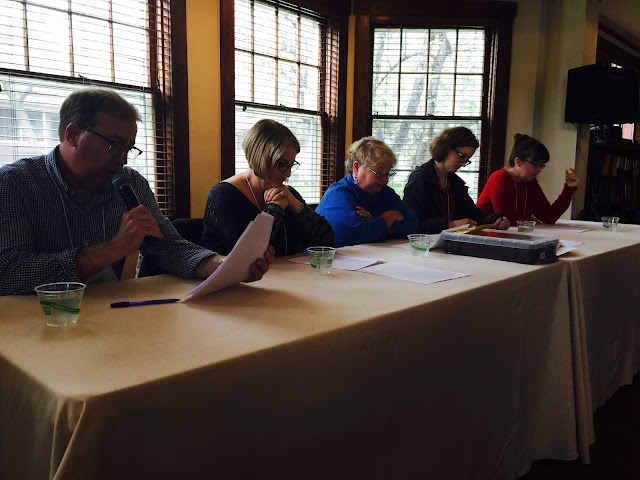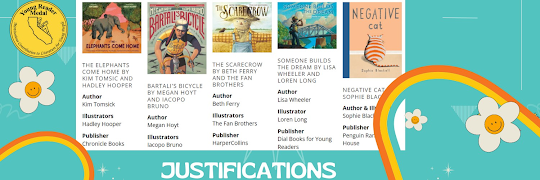
Demystifying
the Book Selection Process: Featuring Tattered Cover buyer Stephanie Coleman,
and children’s books librarians McCourt Thomas and Ida Olson
Have
you ever wondered how books get chosen for bookstores or libraries? In a gathering of authors, librarians, and book buyers, attendees enjoyed the rare opportunity to hear the inside
scoop - how are book buying decisions made at the corporate level?
Our panel of experts included Stephanie Coleman, McCourt Thomas, and Ida
Olson. At the time of the meeting, Stephanie served as Director of Buying at Tattered Cover Bookstores which has
four brick and mortar Denver locations plus airport stores. McCourt Thomas is a
librarian whose title is Head of Youth Services Lyons Regional LibraryDistrict. Ida Olson is a writer, freelance editor, and served as a middle school
librarian in Cheyenne Wyoming. Each panelist talked about the book buying
process, what factors influence their decisions, and what authors can do to help
their books have the best chance at getting noticed.
McCourt Thomas Head of Youth
Services Lyons Regional Library District McCourt was introduced first. She explained that libraries often have book selection committees, however she
is the decision maker at her location in Lyons. She has a policy she must
follow when making a purchase: to identify two justifications for every
book she requests. Justifications can include things like popular appeal,
starred reviews, good reviews in respected sources, and/or that she read it
herself and strongly recommends the book.
McCourt finds books by reading
sources like Publishers Weekly, KirkusReview, ALA Booklist, , and others respected
publications. She also reads AudioFile Magazine and often checks the Earphone Award. She
likes referencing magazines that provided themed lists (a themed list might be
books about construction trucks, books about inventors, or even books about
underpants).
McCourt says another way she discovers books is through publishers’
webinars featuring upcoming releases. She watches those to see what grabs her
attention. Furthermore, she attends conferences like ALA, PLA (Public Library
Association), SCBWI, and she receives galleys from publishers or she requests
early reads on Netgalley (Netgalley provides e-galleys of
books to vetted readers).
McCourt’s
buying decisions are also influenced by user requests, popular relevant subject
matter, and what moves off the shelf (e.g., action books move more than “issue”
books). Lastly, publishers constantly
send out blurbs about their frontlist. "Frontlist” books are newly released
books, or re-released older books but with new covers.
McCourt reads through
to see what fits the bill. Space at her location is constrained, so she has to
make informed decisions and she typically stocks only one copy of a title.
 |
"Can the text and art of my
picture book cut through the noise and caputre
kid's attention when the primary audience includes
doezens of two, three, and four-year-olds?" BITTY BOT by
Tim McCanna and I HAVE A BALLOON by Ariel Bernstein
do just that! |
McCourt’s big advice for picture
book writers is to think of story time in a library, school, or bookstore, and
then ask yourself, “Can the text and art of my picture book cut through the
noise and capture kid’s attention
when the primary audience includes dozens of two, three, and four-year-olds?” McCourt
says writers should cut out the wordiness and think about strong word choices,
sounds, and page-turns—they matter!
McCourt
explained that librarians often buy their books through large distributors like
Ingram or Baker
& Taylor.
Stephanie
Coleman-Director of Buying, Tattered Cover Books

Stephanie agrees with
McCourt’s sources for discovering books and adds that sales representatives
from the publishing houses also influence her buying decisions. When a sales
rep is excited about a book, the bookstore gets excited about a book. Sales
representatives are often the publishing houses’ gatekeeps. They talk up their
favorites, send specific links from Edelweiss
(Edelweiss is an online source that carries all publishing house catalogs),
share the book specs, plus they share their markup notes(i.e. if there is a
movie coming out, if there are a lot of marketing dollars behind the book, if
the author is going on tour, if the author has any high profile interviews in
the works, like being featured on NPR or a talk show). When making a buying decision, Stephanie also
considers how an author did in their stores in the past and/or how comparable
titles performed in sales. If the bookstore doesn’t have a track record on a
particular author or illustrator, they plug a comp title into their computer
and tally up results to see if they believe a similar title will generate
interest. Sometimes the buyer loves a book and is willing to put in time to
make sure it gets noticed through good in-store handsellers.

When Tattered Cover is
enthusiastic about stocking a title, they purchase three to five copies of the
title (as a general rule). Stephanie noted that she finds it interesting that sometimes
a book in one region is a smashing success while in another region it isn’t a
hit, but there’s no standard answer on why this occurs (other than the obvious
being if a book is released in the author’s hometown or if marketing specifically
targets a region).
Whereas librarians make
their purchases through Ingram
or Baker & Taylor, bookstores buy directly through the publishers (the
receive better pricing, plus they can return with publishers).
DISPLAY: Which books get faced out?
There’s not a clear
formula for this answer, however local authors often receive a front faced
display
as do authors who are offering a signing and authors with “important” books or
popular appeal books. Tattered Cover also has staff who make “Staff Picks”. Under
special circumstances, publishers will send a “dump” which is a display case designed
specifically for a particular book because the bookstore plans to buy quite a
few.
Ida Olson: writer, freelance
editor, and middle school librarian in Cheyenne Wyoming. Email: idaedits at gmail dot
com
When Ida
Olson isn’t winning the Sue Alexander award or
writing hysterical tweets @IdaOlson, she’s a busy junior high librarian for
seventh and eighth grade students. Ida acquires 300-500 titles per year for her library. She
noted that signed books are a big deal to students. When making buying
decisions, she agrees with McCourt and says she is obligated to find justifications
such as reading the book herself or finding review sources through School Library Journal, Booklist, etc.
Like McCourt, Ida purchases through Ingram, Baker and Taylor, and also Follett (they provide books plus
library management software). These websites provide useful vetting tools, for
example, when considering a particular book these websites list all of the reviews
in one spots: reviews from School Library
Journal, The Horn Book Review, Publisher’s Weekly, Booklist, Kirkus Reviews, etc.
can all be seen on a single page so
the research is easy to compare and consider. Ida admits she tends to buy books
that have stars, but she also wants to know “what the people really think” and
she visits Amazon reviews, too. One thing Ida says that
bothers her is when reviewers say a story is cliché, because really, “How many
things are cliché to a twelve-year-old?” Though it is hard for
self-published authors to land in libraries, self-published authors now have a
better chance to capture librarian’s attention by meeting the required
justifications of positive reviews, since Kirkus
now offers unbiased paid-for reviews. If a self-published book gets a star or a
positive review, librarians are able to use that as a justification.
Ida is passionate about advising
librarians to “select broadly”—books need to represent everyone and help
showcase various viewpoints. Ida’s
library choices represent a broad range of colors and experiences. As far as
displays go at her library, she rotates to make sure everything gets displayed
as eye candy for kids. She also creates seasonal displays, back to school
displays, sports displays, Halloween and holiday displays, and displays to
promote what the reading teacher is working on in their classrooms.
QUESTIONS:
1.
How IMPORTANT is a book cover in the buying selection process?
The answer was unanimous:
it’s HUGE!
“Cover is key,” Stephanie
says.
Titles:
It seems like there are 50 generic one-word title, but that’s okay. Titles
don’t influence as much as covers do.
Staff
recommendations also influences buying decisions.
McCourt advises to avoid
the curse of the brown cover and says you should check out some of School Library Journal blogger, BetsyBird (Fuse 8) to see what she says about sepia or brown covers.
2.
What about ARCS
(Advance Reader Copies)? How
often do you receive/read them; how do you feel about authors reaching out to
you with an arc; do you have more than you have time to read?
Stephanie
from Tattered Cover says they receive ARCs all the time. She considers then extremely
helpful. Though she doesn’t have time to read every single ARC, she does pass
many to the Teen Advisory Board or she puts them in the staff break rooms and also
gives to bookstore volunteers.
McCourt
says she can request ARCs through Netgalley in order to receive online copies. She
often reads picture books through this source and makes fast buying decisions.
Book bloggers can sign up to read ARCs through Netgalley and if approved, they
too can receive preview copies to read on phone, tablet, or e reader.
3.
Are there any factors
that influence your book buying habits that might surprise authors?
Author’s should know what the summer
reading program is going to be and see if their book is a fit. Also, check out
“Friends of the Library” to find out the yearly, nationwide collaborative
theme. Collaborative themes for 2017,2018, and 2019: construction (2017); music(2018); space(2019).
Authors who are willing to come do
story time, author event, or teen event influence a buyer’s decision.
4.
At what point do you
choose to take a book off your shelf/remaindered books
IDA: 10 years old; looks at how many
times book has been checked out. Considers if a book has a niche value. Even if
it is not checked out often, she considers if the book represents an
unrepresented group and has an important reason to stay.
STEPHANIE: twice a year the bookstore does returns. It’s
important for a bookstore to stay fresh. Diverse books they keep in stock for a
long time. They keep a core backlist.
Has to do an inventory count once a
year. Stephanie says they wait six to
nine months and if the book has absolutely no activity they stop ordering
completely (they do cycle counting). If books are part of a series, they keep the
first book of series and the most recent release at minimum.
MCCOURT – deselection is based on if
a book is damaged, has no checkout activity, or gut decision.
5. What else should we know?
Parting
fast tips: Common core is moving out and narrative nonfiction as well as STEM
are the new hot thing.
Parents
come in and ask for themes (bulldozers, underwear, unicorns)
Story
time attracts the four and under crowd. Use catchy phrases and alliteration to
keep their attention. Read your manuscript out loud and see how it sounds, then
ask someone else to read it to you.
Write
a funny and a scary book!



























